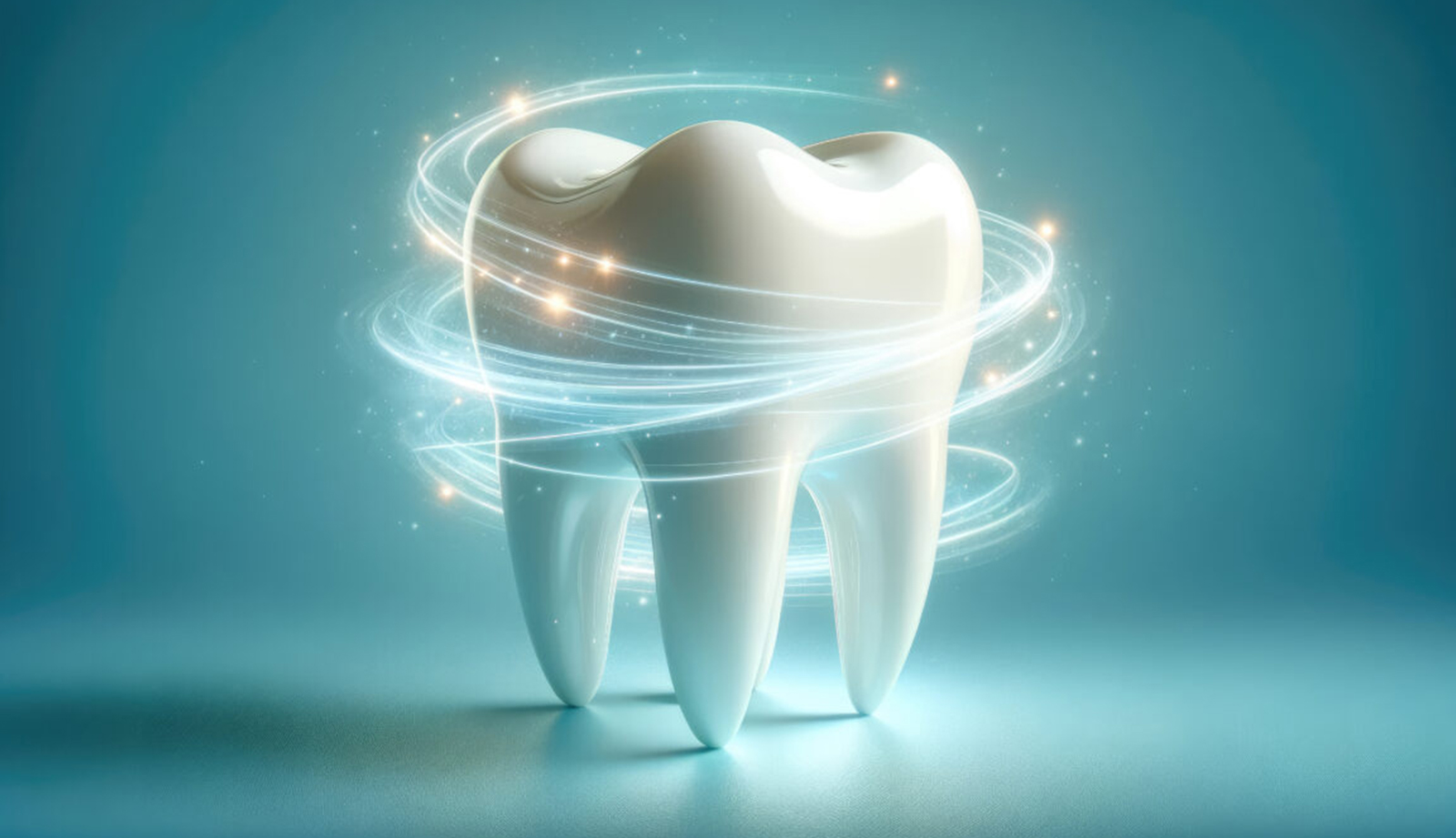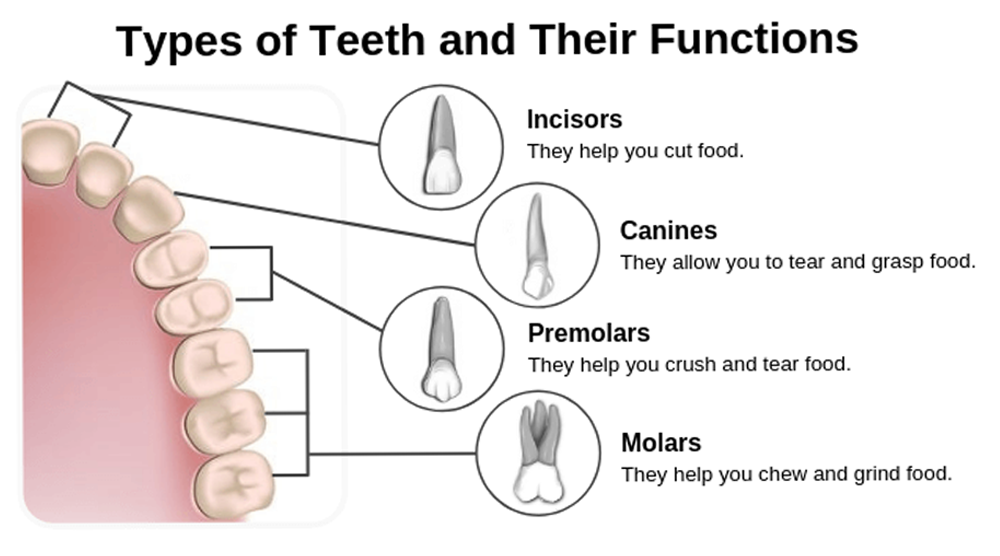
Functions of Different Types of Teeth: Understanding Their Role in Oral Health
Teeth play a fundamental role in our everyday lives, enabling us to chew, speak, and even convey emotion through our smiles. Despite their small size, each tooth in the human mouth is specially designed to perform a unique function, and together, they form an intricate system vital for our health and well-being. The human mouth contains four primary types of teeth: incisors, canines, premolars, and molars. Each has its distinct structure and purpose, reflecting the evolutionary needs of humans over millennia.
In this blog, we’ll dive deep into the anatomy and function of each type of tooth, how they work in harmony, and why proper care is essential to maintain their health.

-
1. The Anatomy of a Tooth
Before exploring the different types of teeth, it’s important to understand the general anatomy of a tooth. Each tooth, regardless of type, consists of three main parts:
-
Crown: The visible part of the tooth above the gum line. It’s covered by enamel, the hardest substance in the human body.
-
Root: The part of the tooth that lies below the gum line, anchoring the tooth into the jawbone.
-
Pulp: The innermost part of the tooth that contains nerves and blood vessels, keeping the tooth nourished and responsive.
The outer layer of a tooth is composed of enamel, which protects it from decay and damage. Beneath the enamel is dentin, a softer material that supports the tooth's structure. The inner core, the pulp, is essential for sensing temperature changes and discomfort. The balance of strength and sensitivity in a tooth allows it to perform specific functions based on its type.
-
2. Incisors: The Front-Line Defenders
Structure and LocationIncisors are the eight thin, flat teeth located at the front of the mouth – four on the upper jaw (maxilla) and four on the lower jaw (mandible). They are the most visible when we smile or speak and are the first teeth to come into contact with food during biting.
Primary FunctionIncisors are designed primarily for cutting and slicing food into smaller pieces. Their sharp, chisel-like edges are perfect for making the initial break in the food, which is then passed on to other teeth for further processing. This function is essential for efficient digestion because food needs to be adequately broken down before entering the digestive tract.
Additional Functions
-
Aesthetics: Incisors play a significant role in the appearance of one’s smile. They help define facial symmetry, especially the central incisors.
-
Speech: Incisors assist in forming certain sounds, particularly consonants like “f” and “v,” where the upper incisors touch the lower lip to produce the sound.
-
3. Canines: The Tearers and Grippers
Structure and LocationCanines, also known as cuspids, are four pointed teeth located on either side of the incisors – two on the top and two on the bottom. They are the longest teeth in the human mouth and have a single, sharp cusp that gives them their distinctive appearance.
Primary FunctionCanines are primarily responsible for tearing and gripping food, particularly tougher substances like meat. Their pointed structure allows them to pierce through food with ease, making them crucial for diets that include fibrous or chewy items.
Evolutionary PerspectiveCanines are remnants of our evolutionary past when our ancestors needed to tear through raw meat and fibrous plant materials. In many carnivorous animals, such as lions and wolves, canines are significantly larger and more pronounced. In humans, they have adapted to a more omnivorous diet, though they still retain their tearing function.
Additional Functions
-
Guiding Jaw Movement: Canines are crucial for guiding the jaw during lateral (side-to-side) movements. They prevent excessive wear on the other teeth by ensuring the teeth don't scrape against each other unnecessarily.
-
Facial Structure: Canines help shape the face, especially in the area around the lips and cheeks, contributing to facial aesthetics and structure.
-
4. Premolars: The Transition Teeth
Structure and LocationPremolars, or bicuspids, are located behind the canines and in front of the molars. Adults typically have eight premolars – two on each side of the upper and lower jaws. They have a broad, flat surface with two cusps, which is where they get their name.
Primary FunctionPremolars serve as the transitional teeth between the sharp, cutting incisors and canines and the large, grinding molars. They are responsible for both tearing and grinding food, making them essential for breaking down food into smaller, digestible pieces before it reaches the molars.
Additional Functions
-
Multi-Functionality: Premolars have a dual role – they act as both tearers and crushers. Their cusp structure enables them to perform multiple tasks, which is essential for efficiently processing a wide variety of foods.
-
Maintaining Proper Bite Alignment: Premolars help in maintaining the proper occlusion (bite) by preventing excessive forward or backward motion of the teeth. They ensure that the jaws close evenly, providing a balanced bite.
-
5. Molars: The Powerhouses of Grinding
Structure and LocationMolars are the largest and strongest teeth located at the back of the mouth. Adults typically have 12 molars – three on each side of the upper and lower jaws, including the wisdom teeth, which are the third set of molars.
Molars have a broad, flat surface with several cusps designed for crushing and grinding food into smaller, manageable pieces. The large surface area and multiple cusps allow for more efficient processing of food, making molars essential for preparing food for digestion.
Primary FunctionMolars are the heavy lifters of the chewing process, responsible for grinding and pulverizing food into a soft, pulpy mass that is easier to swallow and digest. They are particularly important for processing starchy and fibrous foods, which require significant mastication before swallowing.
-
First Molars : Molars help support the cheeks and facial structure, particularly in maintaining the overall width of the jaw.
-
Second Molars : Erupting around age 12, they support the first molars in grinding food.
-
Third Molars (Wisdom Teeth) : The last to appear, usually in late adolescence or early adulthood. Wisdom teeth are often removed because they can become impacted or cause alignment issues.
Additional Functions
-
Supporting the Structure of the Mouth : Molars help support the cheeks and facial structure, particularly in maintaining the overall width of the jaw.
-
Crucial for Maintaining Jaw Balance : They play a key role in distributing the forces of chewing evenly across the jaw, preventing overloading on other teeth.
-
6. The Importance of Wisdom Teeth
Wisdom teeth are a unique subset of molars that usually erupt in late adolescence or early adulthood. Their evolutionary purpose was to provide extra grinding power when our ancestors had a tougher, more plant-based diet. However, as human diets and jaw sizes have changed over time, wisdom teeth have become less essential.
In modern times, many people experience complications with their wisdom teeth, such as impaction, overcrowding, or infection, leading to their removal. While they once served a crucial purpose, many people today can maintain excellent oral health without them.
-
7. Why the Right Care is Essential for All Teeth Types
Each type of tooth plays a specific role in the chewing process, but they all rely on one another for overall efficiency. If one type of tooth is damaged or missing, it can affect the entire system, leading to misalignment, uneven wear, and digestive issues.
To maintain the health of your teeth, it’s important to:
-
Brush and Floss Regularly: Keeping plaque and bacteria at bay is essential for preventing cavities and gum disease.
-
Visit Your Dentist Regularly : Professional cleanings and checkups can help catch potential issues before they become severe.
-
Eat a Balanced Diet: Foods rich in calcium, vitamin D, and phosphorus strengthen teeth and keep gums healthy.
-
Protect Teeth from Damage Wear a mouthguard during sports and avoid habits like teeth grinding or chewing on hard objects.
-
8. Conclusion: Teeth as a Team
Teeth are much more than simple tools for chewing food; they are part of a finely tuned system that has evolved over millions of years. Each type of tooth – incisors, canines, premolars, and molars – plays a unique role in helping us break down food, maintain facial structure, and speak clearly.
Understanding the functions of different teeth is key to appreciating their role in our overall health and well-being. Whether tearing, cutting, or grinding, every tooth is a critical player in the team, working together to ensure that we can enjoy our food, stay nourished, and smile confidently.
